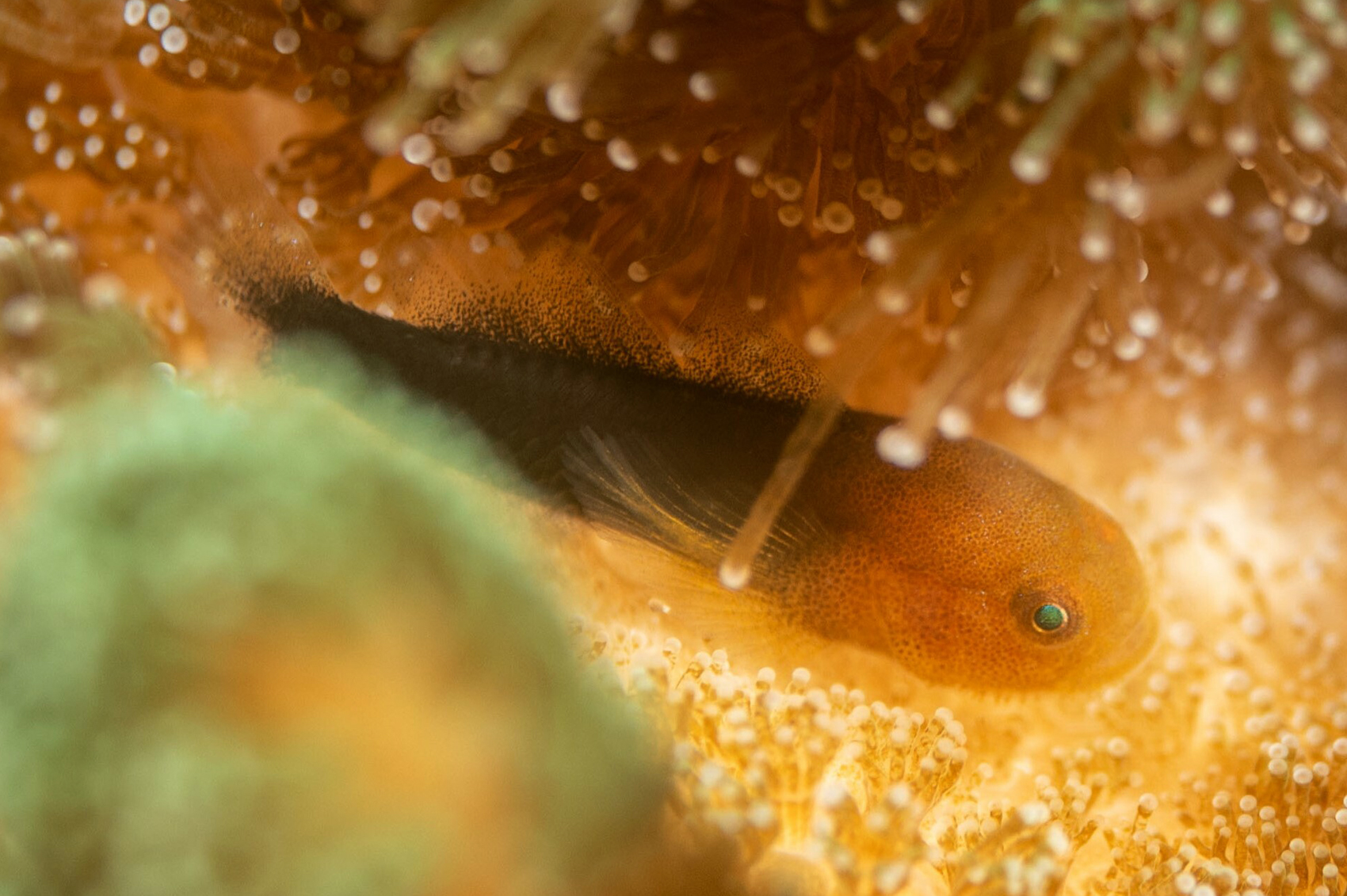Redhead Pocillopora Goby, Paragobiodon modestus (Regan 1908)
Other Names: Redhead, Redhead Goby, Warthead Coralgoby, Warthead Goby, Warty-headed Goby

A Redhead Pocillopora Goby, Paragobiodon modestus, in the coral Pocillopora aliciae, Cabbage Tree Bay, Manly, New South Wales, May 2022. Source: John Sear / iNaturalist.org. License: CC by Attribution-NonCommercial
Summary:
A small blackish to brownish coral goby with a reddish-orange head and relatively short head papillae. This species lives within the branches of Pocillopora corals.
Cite this page as:
Bray, D.J. 2023, Paragobiodon modestus in Fishes of Australia, accessed 01 Jul 2025, https://fishesofaustralia.net.au/Home/species/138
Redhead Pocillopora Goby, Paragobiodon modestus (Regan 1908)
More Info
|
Distribution |
Rowley Shoals and offshore reefs of north Western Australia, Ashmore Reef and Cartier Island in the Timor Sea, and the northern Great Barrier Reef, Queensland, to Broughton Island, New South Wales, with juveniles to Sydney; also Lord Howe Province in the Tasman Sea. Elsewhere the species occurs in the Indo-west-central Pacific, from the Red Sea and East Africa, to the East Indian region and Papua New Guinea, north to Japan (Ryukyu Islands), east to French Polynesia. Inhabits Pocillopora corals, relying on the coral host for food, shelter and a breeding site on which to lay their eggs. |
|
Features |
Dorsal fin VI + I, 9; Anal fin I, 9-10; Transverse scales 10-11; Longitudinal scale series 22-24. Body depth at level of pelvic fins 3.0-3.4 in SL; mouth strongly curved downward; lips thick; chin heavy and square. Opercles with short, soft prickles or fibrils which also occur from lower margin of preopercles to mouth; pelvic fins also covered with similar prickles. Dorsal fins very close together; dorsal base discontinuous; 2nd dorsal higher than 1st, posterior rays elongated; anal similar to 2nd dorsal but lower; caudal rounded; pectoral broad. Scales ctenoid except head, nape, pectoral region, breast and midventral portion of abdomen; complete pelvic fin frenum and basal membrane. |
|
Biology |
An obligate coral-dweller, with pairs of small groups living among branches of Pocillopora corals. Coral gobies are hermaphrodites. Immature individuals are female and may change sex to become males during the life cycle. |
|
Similar Species |
The Redhead Pocillopora Goby is often mistaken for the Redhead Stylophora Goby, Paragobiodon echinocephalus, which lives in Stylophora corals. While the colour pattern similar to that of P. echinocephalus, the Redhead Pocillopora Goby has shorter papillae on the head. |
|
Etymology |
The specific name is from the Latin modestus (= moderate, modest, unassuming), possibly in reference to the blackish-grey colouration of this species. |
|
Species Citation |
Gobiopterus modestus Regan 1908, Transactions of the Linnean Society of London 2nd Series Zoology 12(3): 242, pl. 29(1). Type locality: Egmont Island and Salomon Island, Chagos Archipelago, Indian Ocean. |
|
Author |
Bray, D.J. 2023 |
|
Resources |
Redhead Pocillopora Goby, Paragobiodon modestus (Regan 1908)
References
Allen, G.R. & Erdmann, M.V. 2012. Reef fishes of the East Indies. Perth : Tropical Reef Research 3 vols, 1260 pp.
Allen, G.R., Hoese, D.F., Paxton, J.R., Randall, J.E., Russell, B.C., Starck, W.A., Talbot, F.H. & Whitley, G.P. 1976. Annotated checklist of the fishes of Lord Howe Island. Records of the Australian Museum 30(15): 365-454 figs 1-2 (as Paragobiodon echinocephalus)
Francis, M. 1993. Checklist of the coastal fishes of Lord Howe, Norfolk, and Kermadec Islands, southwest Pacific Ocean. Pacific Science 47(2): 136-170 figs 1-2
Gill, A.C. & Reader, S.E. 1992. Fishes. pp. 90-93, 193-228 in Hutchings, P. (ed.) Reef Biology. A Survey of Elizabeth and Middleton Reefs, South Pacific. Canberra : Australian National Parks Vol. 3, Kowari 230 pp.
Grant, E.M. 1975. Guide to Fishes. Brisbane : Queensland Government, Co-ordinator General’s Department 640 pp.
Hoese, D.F. 1986. Family No. 240: Gobiidae. pp. 774-807 figs in Smith, M.M. & Heemstra, P.C. (eds). Smith's Sea Fishes. Johannesburg : Macmillan South Africa xx + 1047 pp. 144 pls.
Larson, H. 2016. Paragobiodon modestus. The IUCN Red List of Threatened Species 2016: e.T193217A2210280. http://dx.doi.org/10.2305/IUCN.UK.2016-3.RLTS.T193217A2210280.en. Downloaded on 26 June 2018.
Marshall, T.C. 1964. Fishes of the Great Barrier Reef and Coastal Waters of Queensland. Sydney : Angus & Robertson 566 pp. 136 pls.
Myers, R.F. 1999. Micronesian Reef Fishes. A comprehensive guide to the coral reef fishes of Micronesia. Guam : Coral Graphics vi 330 pp. 192 pls.
Randall, J.E. 2005. Reef and shore fishes of the South Pacific. New Caledonia to Tahiti and the Pitcairn Islands. Honolulu : University of Hawaii Press 707 pp.
Regan, C.T. 1908. Report on the marine fishes collected by Mr. J. Stanley Gardiner in the Indian Ocean. Transactions of the Linnean Society of London 2nd Series Zoology 12(3): 217-255, pls 23-32 See ref at BHL
Russell, B.C. 1983. Annotated checklist of the coral reef fishes in the Capricorn-Bunker group, Great Barrier Reef, Australia. Great Barrier Reef Marine Park Authority. Special Publication Series 1: 1-184 figs 1-2 See ref. at BHL





